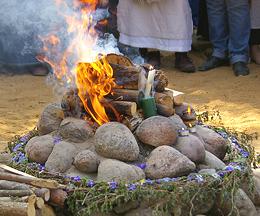
Overview
Here you will find a quick look at basic concepts of modern Pagan philosophies and their current expression. We take a fairly Eurocentric view, which includes the non-native Paganism of North America, Australia and New Zealand. While there are significant parallels with native religions worldwide, it is best to consider them separately, as their environments and history are so dissimilar.
Paganism is Not "A Religion"
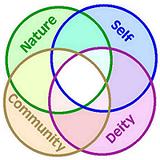 Paganism today is a movement encompassing a dizzying array of philosophies,
associations, attitudes, and yes, religions. There are many happy to call
themselves Pagans, but some prefer Heathen (German for Pagan) or
Witch, and some prefer no classification.
Paganism today is a movement encompassing a dizzying array of philosophies,
associations, attitudes, and yes, religions. There are many happy to call
themselves Pagans, but some prefer Heathen (German for Pagan) or
Witch, and some prefer no classification.
Current thinking presents Paganism as consisting of four Orientations. Most Pagans, groups or individuals, focus on one of these Orientations, but all overlap with the other three, in varying degrees.
Nature:
This Orientation is so prevalent Paganism has been called "a group of Nature religions". Pagans see themselves as embedded in Nature, participating in the world, not as masters and exploiters, but as protectors of the Earth and all life. Some are vegetarians, or even vegans, in support of this involvement. Many are Animists, considering all things endowed with consciousness appropriate to their place. Larger entities are seen as summations of the smaller consciousnesses within them.Deity:
Gods and Goddesses are recognized and respected by almost all Pagans, even most atheist Pagans, but there are many concepts of exactly what Deities are. To atheists, they are aspects of the human psyche, to others, they are living beings quite separate from humans, to all they are symbols representing complex relationships. Many Pagans have a big dose of Deity in their Orientation, and many have a special relationship with one or more of them. The concept of the one, and only one, great all powerful, jealous, and vengeful Creator God of the Abrahamic religions is roundly rejected by Pagans.Self:
This Orientation recognizes the Divine within the Self. Emphasis is on self development, becoming wiser, stronger, more compassionate, and more magical, to be of greater service to the world. Magical practices are included here, including, but not exclusive to, Witches and Sorcerers. Many Witches are also strongly Deity oriented, especially to the Goddess Hekate (say "Hekatee"), and there is usually a strong Nature Orientation included.Community:
Here emphasis is not on the individual, but on harmony and continuity of the Family and Community. Immortality is to the Family, not the Individual. Veneration of Ancestors, household spirits, and hospitality to strangers are major aspects of this Orientation. In many cases a strong Deity Orientation is also present.What Does Paganism Offer?
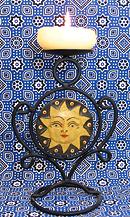 Paganism offers a spiritual path that is softer, gentler and more
satisfying than any offered by the Abrahamic religions, or Secular
Materialism. It is not a path you must blaze alone, because it is
the path of your ancestors, and it is a path being turned to by a
growing number of people around the world.
Paganism offers a spiritual path that is softer, gentler and more
satisfying than any offered by the Abrahamic religions, or Secular
Materialism. It is not a path you must blaze alone, because it is
the path of your ancestors, and it is a path being turned to by a
growing number of people around the world.
Paganism offers freedom from belief - in exchange for understanding. Belief is the very center of Christianity, but has a rather minor place in Paganism. Belief cripples the mind, as psychologists and philosophers well understand. People choose belief so they can be absolutely certain they are right, without bothering with any thinking, and no matter how wrong they may be.
Believers shut their minds and are blind to facts counter to their Belief. Believers are easily manipulated by demagogues and rabble rousers, as we have recently seen so well in our politics. Many demagogues and rabble rousers make a very good living exploiting believers.
Paganism is about connectivity and relationships. You are the center of your universe, but that is meaningless without context. Paganism promotes communion with the Earth and all it's living beings, large and small, with the Elemental Realms, with our ancestors, and with people living today. There is also an undercurrent of detachment from authority, both political and ecclesiastic.
Paganism is not at all at odds with Science, but complimentary to it. This is especially clear with classical physics having reached its limits - yet there is still obviously much beyond those limits.
Just beyond those limits is Quantum Physics, sailing perilously close to magic. There's a famous statement, given in many wordings and attributed to various physicists (earliest attribution is to Niels Bohr), but basically, "If you think you understand quantum physics, you are wrong". Nonetheless, quantum physics has much useful to offer, and so has Paganism, though it is easier to understand.
The Abrahamic religions disparage the world in which we live, and our lives in this world. They ask for mindless belief in exchange for promise of a far better afterlife, an afterlife they actually know nothing about and can offer no evidence for. Pagans consider the world we live in to be sacred, and all lives within it to be sacred. This is reality, not empty promises in turn for obedience.
One thing that Paganism does not offer is a promise of forgiveness in the afterlife. As a Pagan you are totally responsible for your actions, and, as they say, Karma can be a bitch. Of course, the monotheists are just as bound to responsibility. They just imagine they have a way to escape it - through mindless belief.
But, OK, You're a Hardened Sceptic
A sceptic may think this is all just self manipulation and delusion, a sort of mental placebo. Well, the things being manipulated are all real elements of a person's real and perceived world. Besides, recent research has shown that placebos work even if the person taking them knows they are placebos.
Do keep in mind that Scientific Objectivism is a closed box with impenetrable walls. It has very strict rules and possibilities. Sorry, no Warp Drive. If you wish perpetual survival for yourself, or for humanity itself, you'd better be looking outside the box. If you wish to engage with Other Intelligences, you need to look outside the box for that too.
Besides, a Pagan lifestyle is a lot more fun than scepticism, and the parties are better. Give it a try, you may like it. Just start introducing a few little elements, a few gentle rituals, and let it grow. I knew a couple of hard core atheist-realists who played around with mock rituals for fun - and ended up as Pagan priests.
Foundation
 In the beginning, there was Nothing - but Nothing is simultaneous
with Everything. Nothing is the mutual negation of Positive and
Negative. Nothing has the potential to express itself as Everything,
by bursting into an infinitely fine haze of Positive and Negative.
Aspects of this haze are then capable of recombining in an infinite
number of ways, to form stars, planets, all we can see and feel,
and much more besides.
In the beginning, there was Nothing - but Nothing is simultaneous
with Everything. Nothing is the mutual negation of Positive and
Negative. Nothing has the potential to express itself as Everything,
by bursting into an infinitely fine haze of Positive and Negative.
Aspects of this haze are then capable of recombining in an infinite
number of ways, to form stars, planets, all we can see and feel,
and much more besides.
You must be clear that of Positive and Negative, neither is "good" nor the other "evil". Good and Evil are purely constructs of human understanding, and have no place outside of human protocols. Within the realm of human protocols, however, concepts of Good and Evil are extremely important for progress along the infinite path of becoming.
The basic error of the Abrahamic Religions is found in the story of the Garden of Eden. Humans have eaten of the fruit of The Tree of Knowledge of Good and Evil. "Behold, he has become as we, knowing the difference between Good and Evil".
This is a triumphant step for humanity on the path of becoming. It is a huge step beyond the animal state. Problem: it brings with it responsibility. Each man and each woman, knowing the difference between Good and Evil, is responsible for his or her actions. Accepting this, and acting in accordance, is essential to personal progress, and the progress of humanity as a whole.
Yet, these "revealed religions" blame this advancement on "sin", and seek a return to the "state of grace", to the animal state, where God is responsible for everything. They hold that all sins are forgiven by simply believing in God (or his incarnation as Jesus), or by submission as obedient property of Allah. This forgiveness is promised by the priesthoods, without fear of ever having to deliver.
This isn't going to happen - there is no going back. Pandora's Jar has been opened. You must accept responsibility for your own actions, or you fall into the realm of the subhuman. That is a basic tenant of Paganism.
Who are Pagans?
 First lets clear up a misconception promoted by churches and the
popular media. Pagans are not at all related to Satanists. Satanism
is a "reversal" child of Christianity and Hebraic tradition, and has
nothing to do with our pre-Christian religions or with modern Paganism.
Some into esoteric forms of Satanism may object to this definition, and
some of these groups are sufficiently well behaved to be accepted by
Pagan communities, but certainly don't define Paganism.
First lets clear up a misconception promoted by churches and the
popular media. Pagans are not at all related to Satanists. Satanism
is a "reversal" child of Christianity and Hebraic tradition, and has
nothing to do with our pre-Christian religions or with modern Paganism.
Some into esoteric forms of Satanism may object to this definition, and
some of these groups are sufficiently well behaved to be accepted by
Pagan communities, but certainly don't define Paganism.
Let's also clear up another misconception, that Paganism is a religion of country folks. This was promulgated by early Christians and amplified by Baroque and Victorian romantic notions. Paganism has always been at its height in the urban centers where the arts and commerce flourished. This remains true today. While a number of prominent Pagan writers revel in their country homes and connection with nature, the Pagan Revival is centered firmly in the costal cities that are the centers of the arts, science and commerce. The country bumpkins pretty much all claim to be Christians, but most pretty much ignore the teachings of Jesus.
On the whole, the question of who Pagans are isn't an easy one to answer. Significant research has been done on this subject in English speaking countries. The prominent social polling organization, Pew Research, calculates there are over 1 million Pagans in the United States alone.
In some European countries, including in the Baltic and Caucasus, Pagan movements are officially recognized by governments. Now (2020), Italy has certified a Pagan organization as official. In Armenia, the first country to be converted to Christianity, the Church has accepted the Pagan movement as an ally in preserving Armenian traditions and identity.
It must be firmly noted that the majority of Pagans, especially here in North America, are solo practitioners, belonging to no circle, coven or other organized or disorganized group. They keep contact as a community mainly through magazines and the Internet.
Back in the "Teen Witch" era of the 1970s, the average age of folks declaring themselves Pagan was about 16. A study that closed in 2014 found it was now older than 26. That study group is currently working on a re-run which will probably push the average age higher. Of course there are many Pagans today who are well over 26 - those in the 70+ bracket who paved the way for the younger set.
A study conducted in the West Coast States of the United States found Pagans were generally very well educated, including many professionals, and tended to be avid readers, much more so than the general population. In North America, Pagan communities are most dense on the East and West coasts of the United States, the commercial and cultural centers.
Pagans are found in many walks of life, but some are rather secretive about it. This is particularly true of teachers, as some have been fired, in both the UK and the US, when school administrators found they were Pagans. In some regions, like the US "Bible Belt", other careers are also at risk, and in Islamic regions, lives are at serious risk.
Gods & Goddesses
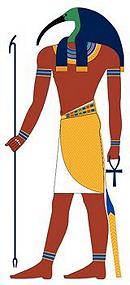 Pagans respect the Gods and Goddesses. They are real, but concepts of
just what they are vary widely. Some consider them to be entities
unto themselves, completely independent of humans. At the other end are
those who consider them elements of the human psyche.
Pagans respect the Gods and Goddesses. They are real, but concepts of
just what they are vary widely. Some consider them to be entities
unto themselves, completely independent of humans. At the other end are
those who consider them elements of the human psyche.
Most Pagan orientations are polytheistic, pantheistic or animistic, or some combination of these, but there are a few that consider themselves monotheists, and quite a few that consider themselves atheist. There is a thick book, Godless Paganism, in which many non-theistic Pagans express how and why they are Pagans. What unites all these diverse people as Pagans is the use of ritual, simple or complex, deep respect for all life, the natural world and universe, and a disregard for ecclesiastic authority.
Some Pagans insist that you must believe in multiple Gods and Goddesses that have an independent existence from you, or you can't be Pagan. These are our "fundamentalists", and they say this must be so because it was the way of our ancestors. Many Pagans do not agree, and, in fact, our ancestors had rather diverse attitudes towards the nature of Deities, of humanity, and of the universe itself.
Pagan Gods and Goddesses have been described as humanly understandable personifications of the forces of nature, and aspects of human personality and culture. This imagery was particularly helpful for explaining complex interactions in a pre-literate society, but is still powerful for cultural and personal purposes today.
Observe how great temples are no longer built to the Greek and Roman Gods and Goddesses. The early Christian emperors decreed, and enforced, a death penalty for Pagan worship. Yet observe how important they remain in literature and art. Could there have been a Renaissance without them? These are powerful images that are still relevant today.
Named Gods and Goddesses gain power and relevance with acceptance by a community. It matters not whether they are named and defined by that community. They personify real powers that affect our lives, and are part of the coherence and understanding of human community. They are to be respected.
One theory holds that the Gods were designed and named by communities, but over time, the energy sent to them by their followers enabled them to consolidate into actual independent beings, beings of a very different sort from what we are. These beings may have an interest in human affairs, and may sometimes agree to aid humans, but they have their own priorities, and sometimes ask humans to assist.
People say they communicate with Deities. Can these Deities actually be independent beings, however they originated? That seemed scientifically absurd, but no longer seems so absurd to science. If we, in our consciousness, operate in the physical world, but are not of the physical world, could not other beings also reside in that realm? For more on this new science see our Subtle Body - 21st Century page.
Many Theist Pagans concentrate entirely on a single God or Goddess, while accepting there being many others. This is called "Henotheism". Some people have said they have been "serially monotheistic", changing focus to a different single Deity as their lives changed. This is called Kathenotheism, worshiping one Deity at a time, each in turn as the Supreme Deity.
Gods and Goddesses can be thought entirely personal, or they can be considered archetypes (Jungian Paganism). Even those who do not accept Gods and Goddesses as such often use their names freely in conversation, because they are a convenient shorthand for discussion of complex matters.
The most important thing is Understanding. You must understand the powers and influences that compose a Deity that interests you, and for what purpose those powers and influences are relevant to your life. This takes serious study, not just making stuff up. You must understand how you desire to interact with that Deity and act consistently with that understanding. It matters not whether you think of that Deity as part of yourself or as an external being, the Deities are real.
The monotheistic God was patterned after human kings, to justify the actions of human kings. All other aspects of nature and human society were subservient to the king. Since that God is designed by His worshipful community, the design needs to change with changes in the community. Some now claim a "patient, loving God", quite at odds with the jealous and vengeful God of their scriptures. This causes tremendous inconsistency in the Christian religion.
Yes, the concept of a single all encompassing God is a powerful tool for promoting tyranny, wars of aggression, and suppression of "infidels", but, by its nature, contains many inescapable conflicts and inconsistencies of both logic and theology.
"Mommy, if God is so good, sees everything and is all powerful, why do
such bad things happen to so many good people?" Because of such conflicts
and inconsistencies monotheistic religions have had to appoint at least one
other being with God-like powers, such as Satan, but just not call him a
God, because there can be only one, they say. This leads to further
inconsistencies. "It's hard to believe in God when certain people are
never smitten with lightning bolts."
Household Spirits
 [Housewight (English, current); Húsvættir (Norse);
Lares (Roman); Domovoy (Russian); Domowik (Polish); Gasin (Korean); Cofgodas
(Anglo-Saxon)]
[Housewight (English, current); Húsvættir (Norse);
Lares (Roman); Domovoy (Russian); Domowik (Polish); Gasin (Korean); Cofgodas
(Anglo-Saxon)]
Household Spirits and/or Deities are a feature of pretty much every ancient Pagan religion, and may include ancestral spirits. They are taken seriously by a number of current Pagan forms, especially by Witches. Their powers are much less than those of the major Deities, but are strong locally. Their place is most often in the kitchen, previously the hearth.
The most well known and studied are the Lares of Roman Paganism, which were important in every household, with special places, and to whom offerings were periodically provided. Household spirits are generally helpful, especially if one becomes sensitive to their communication, but they like things clean and definitely dislike conflict in the household.
The photo shows an installation placed for Housewights, offering a nice
jar to live in, and guardian shells. They are disembodied spirits so can go
in and out of the jar without it being open, and, like a TARDIS it is much
larger on the inside than on the outside. The house itself, built of natural
materials from the Earth, is considered also to have a Spirit of its own.
Myths and Archetypes
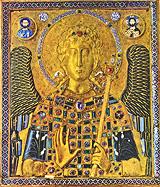 Myth is very important to every religion of this world, including
yours (whatever it may be). Myths are not things that have happened
in our world - but metaphors - they are not be taken literally, but
as guides and patterns. They define the nature of humans and their
societies in an understandable way.
Myth is very important to every religion of this world, including
yours (whatever it may be). Myths are not things that have happened
in our world - but metaphors - they are not be taken literally, but
as guides and patterns. They define the nature of humans and their
societies in an understandable way.
Archetypes are very much part of the mythic realm. They are master patterns for behavior and the structure of society, for both the individual and the community. They influence all members of the community through the unconscious mind. Persons who become very prominent within a community tend to be aligned with one of its archetypes, warrior, magician, healer, etc.
Christianity has tried to suppress archetypes, feeling they lead far too easily to polytheistic Paganism. Perhaps the strongest Christian archetype is Mary, who, in some forms of Christianity, became a major object of worship, especially as a replacement for Vesta, the Roman goddess of the household. In reaction, other forms, particularly Protestantism, have relegated her almost to insignificance. The warrior archangel Michael has also filled an archetype roll. Jungian psychology has placed Jesus as the archetype of the self.
Was Jesus a living person or a myth? There is very scant non-Christian evidence that he was a living person, and what little there is remains highly suspect, some of it clearly forgery. Some scholars consider him entirely mythical, but most are satisfied with "everyone knows he was a real person" as evidence of his existence. Many scholars who are certain he was a physical person still freely admit that much written in the Gospels is mythical. Those who believe the Bible is the unerring Word of God must first choose which of the many versions, all revised and edited by men, is the unerring one.
Whether or not Jesus was a real person is a relatively modern concern. In the days of early Christianity, people were quite accustomed to myth and understood its purpose in defining their culture. In the end, it doesn't matter - the story of Jesus fills a mythic role.
Belief
 There are two forms of Belief. One is totally necessary - the
other cripples the mind.
There are two forms of Belief. One is totally necessary - the
other cripples the mind.
Hard Belief:
This is faith based belief, without examination, and without evidence. It is belief based on "authority", whether from written sources (ancient or recent), persons (living or dead), or the birth community. This form of Belief is extremely popular, because it relieves the believer from having to think. It allows them total certainty they are absolutely right, no matter how wrong they are. Believers are very easy to manipulate.Prominent promoters are the Christian Churches, and especially Islam, but it isn't restricted to religion - let me present QAnon. Hard Belief cannot be changed from without, don't bother trying. Psychologists find that a believer (in whatever), presented with incontrovertible evidence their belief is error, goes away from the encounter believing even more strongly. They are unable to use logic with anything that touches their belief. This sort of Belief can be broken only from within, and that can be very traumatic to the believer.
Soft Belief:
This is Belief we can, and must, live by. This form is appropriate for Pagans, in spirituality as well as general living. It is a working Belief supported by evidence, and particularly by personal experience. This sort of belief enhances the mind, rather than crippling it. Science is the poster child for Soft Belief. Hard laws of Science have been changed time and again when new evidence became known. Science has been valid for physical reality only, but today, scientists are increasingly accepting that physical reality is not "all there is" - based on evidence. What exactly non-physical reality is, is still undefined.Worship
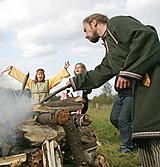 Are Gods and Goddesses to be worshiped? They are very much to be respected
for what they personify - no matter what your concept of the Deities might
be. We do not, and cannot really know what they are. They may be consulted,
they may be asked for help or favors. Some may try to propitiate them, some
even threaten them (dangerous). Community defined deities may have priests
to explain them and interface with them, but do the Deities actually have
need for worship?
Are Gods and Goddesses to be worshiped? They are very much to be respected
for what they personify - no matter what your concept of the Deities might
be. We do not, and cannot really know what they are. They may be consulted,
they may be asked for help or favors. Some may try to propitiate them, some
even threaten them (dangerous). Community defined deities may have priests
to explain them and interface with them, but do the Deities actually have
need for worship?
Persons who work with Deities on a regular basis assure us they appreciate being recognized and respected. Regular offerings and respectful greetings are evidence of that respect. You may consider this respect as worship. One hint: If you have not established a regular and respectful relationship with a Deity, don't bother asking for favors, they will be ignored, if you are lucky. Deities are busy about Deity things, with Deity objectives, and only a fool would claim to know what those are. Deities may also ask you to do things for them. You can decline, but if you make promises, you'd better deliver.
As with other forms of magic, worship works most effectively on the self. Formal worship serves, often quite powerfully, to reinforce the connection between the person or community and the Deity subject to the worship, and to reinforce the definition of that Deity in the minds and lives of the worshipers. Worship should not be disparaged, it can be very important to a person's Pagan practice, or to the cohesion of a community - no matter what you concept of Deities is.
Ritual & Liturgy
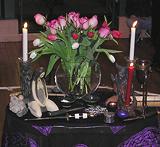 Ritual is a defining aspect of Paganism. Even atheist Pagans engage in
ritual, simple or complex, personal or communal. It is a practice that
works to focus, stabilize and give meaning to our lives. Most Pagans
maintain an altar in their home. It can be tiny and very simple, or
quite complex. What matters is that it provides a meaningful focus in
life. A daily ritual of addressing the subject of the altar is very
common and serves to initiate the day in a familiar way.
Ritual is a defining aspect of Paganism. Even atheist Pagans engage in
ritual, simple or complex, personal or communal. It is a practice that
works to focus, stabilize and give meaning to our lives. Most Pagans
maintain an altar in their home. It can be tiny and very simple, or
quite complex. What matters is that it provides a meaningful focus in
life. A daily ritual of addressing the subject of the altar is very
common and serves to initiate the day in a familiar way.
The importance of ritual is very much appreciated by mainstream religions, but their clergies maintain control of those rituals and their performance. Such public offerings are called "Liturgy". Standard liturgy for particular stages of life, such as birth, marriage, coming of age, death, etc. is a way the priesthoods maintain continuous control over the lives of their congregations.
Some Pagan organizations may also have standard liturgy, but if it has become control oriented, patterned after the mainstream religions, then it is an organization to avoid, probably one promoting a cult of personality around its leader. Leaders intent on building a personality cult prefer weak followers - be strong and avoid them.
Sacred Space
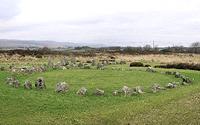 Among Pagans, you will very often hear of "Casting a Circle". What is
this and why? Concerning Sacred Space, Pagans are in a nomadic mode.
Christianity was spread by blood and fire, all the sacred Pagan temples
of Europe were destroyed. Of course, in the New World, and "Down Under"
there never were any. Lacking permanent sacred sites, Pagans must create
them on the fly. There are various paths to Sacred Space, and some are
described in our page Defining Sacred
Space.
Among Pagans, you will very often hear of "Casting a Circle". What is
this and why? Concerning Sacred Space, Pagans are in a nomadic mode.
Christianity was spread by blood and fire, all the sacred Pagan temples
of Europe were destroyed. Of course, in the New World, and "Down Under"
there never were any. Lacking permanent sacred sites, Pagans must create
them on the fly. There are various paths to Sacred Space, and some are
described in our page Defining Sacred
Space.
"Casting a Circle". is an opening step for many rituals, both private and group. It demarks a space that can be cleansed and made sacred, and dedicated to the ritual. It creates a border clearly marked out to forbid entry of disruptive influences. This is the temple, and when the ritual is finished, it is thanked and dismissed.
A dedicated altar in a private home does not need a circle cast before use. It is a permanent sacred space. Group rituals and certain other operations within that home will need a Circle cast. There are some sacred places in Nature that do not need a Circle cast.
Divination
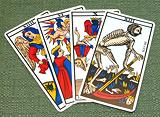 Many Pagans at least dabble in Divination, and some are very serious
about it, while rationalists may scoff. Those who have worked with
divination know it can't predict the future, it is a tool for the here
and now. In the hands of a skilled practitioner, it can be especially
valuable as a counseling tool.
Many Pagans at least dabble in Divination, and some are very serious
about it, while rationalists may scoff. Those who have worked with
divination know it can't predict the future, it is a tool for the here
and now. In the hands of a skilled practitioner, it can be especially
valuable as a counseling tool.
Any Pagan who is interested in divination does hundreds of divinations on themselves, but that doesn't usually work well - the desires and expectations of the reader are too close and interfere with the reading. This is, however, necessary to learn the chosen method, to become comfortable with it and develop a personal style. Then the reader can become helpful to others.
As with Psychologists, there are very good readers, and not so good readers. Essentials of the good reader are detachment from the reading, and empathy for the client - and a method appropriate to the reader. The magic is in the reader, not the method.
I prefer tarot, because each card has deep, complex meanings, but the whole deck cannot quite be completely reconciled. Formulating a fully coherent system has always squirmed away from even the most astute practitioners who have tried. This forces the reader to think along unaccustomed paths during a reading, and the results can be surprising.
Astrology was similarly effective, until it got computerized. Again, the magic is in the reader, and computers aren't magical. Astrology today is still very useful to Pagans as a system of symbology, and as associated with the cycle of the seasons - see Astrology.
Magic & Prayer
 Today, we are living in a time of resurgence of Magic, by Pagans and Witches
(who may or may not consider themselves Pagans). Some Pagans enthusiastically
engage in formal Magic, some to a lesser extent or not at all, and some resist
its use, holding it to be an attempt to usurp the powers of the Gods.
Today, we are living in a time of resurgence of Magic, by Pagans and Witches
(who may or may not consider themselves Pagans). Some Pagans enthusiastically
engage in formal Magic, some to a lesser extent or not at all, and some resist
its use, holding it to be an attempt to usurp the powers of the Gods.
Some leading practitioners report good success rates, but say Magic improves the odds that something will happen, and cannot force it to happen. They also warn that the physical world is most successfully influenced by physical means. When such means are available, use them, but when they aren't, there's Magic.
Magic is often describe by practitioners as taking three basic forms, which may be used alone, or in combination, depending on circumstances and the objective of the working.
Theurgy works to acquire or channel power and/or assistance from a God or Goddess. Prayer is a light form of Theurgy, but to use Theurgy effectively, one must have already formed a relationship with the God or Goddess. They are under no obligation, so a working relationship is needed. This is a point Christians might also take note of.
Energy Magic uses techniques to raise energy that can be applied to a particular goal. It can be by an individual or by a group, often using rituals or meditation. The energy may come from the earth, the sky, the self, or other sources, and is not related to the electromagnetic energy of physical science. This practice requires understanding of, and particularly practice with, the chosen methods.
Psychological Magic is used to influence the internal state of the person, or of the community if performed together. So used, such operations can be quite effective. A skilled practitioner can definitely influence and encourage changes in themselves or another person present, but affecting people remotely is a more questionable matter.
For most folks, that Magic influences worldly things, events, or people remains controversial. Does Magic have an influence in planes other than the physical? Are there such planes? It seems pretty certain there are realms unknown to physics, and I say that from personal experience, as well the experience of others.
Be mindful that Magic can be dangerous. We know little about the
planes on which it works, or just how they may affect the physical world.
Exploration of realms beyond the physical is not invalid or futile, but
it must be cautiously based on careful consideration, experience, and
reference to the work of other serious practitioners. Attempts to force
evidence to support pre-conceived structures or produce "scientific proof"
will fail.
Afterlife
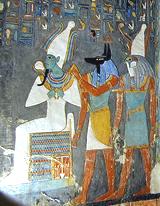 Most Pagan belief systems include concepts of an afterlife, however,
details are unclear. An afterlife can not at all resemble the
kindergarten version promoted by the Christians, or the "gentlemen's
club" pattern of Islam. It cannot be anything like life in this world,
as all the physical infrastructure that supports our form of existence
will have been returned to the Earth from which it came. The Tibetan
Buddhists are the ones that have intensively studied the after death
experience, so should be the ones consulted on these matters.
Most Pagan belief systems include concepts of an afterlife, however,
details are unclear. An afterlife can not at all resemble the
kindergarten version promoted by the Christians, or the "gentlemen's
club" pattern of Islam. It cannot be anything like life in this world,
as all the physical infrastructure that supports our form of existence
will have been returned to the Earth from which it came. The Tibetan
Buddhists are the ones that have intensively studied the after death
experience, so should be the ones consulted on these matters.
Reincarnation is included in many Pagan world views, and should
be mandatory for any that claim heritage from the Druids. That they
believed in indestructibility of the human soul and reincarnation is
among the very few things we actually know about the ancient Druids.
Subtle Bodies
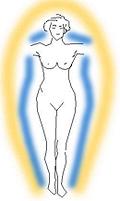 That we have a presence in realms outside the physical is a very important
concept in just about every non-Christian religion in the world, and in
some non-religious philosophies as well. This concept has been very harshly,
sometimes violently, suppressed by the Christian churches, but was accepted
by early forms of Christianity. It survives to this day in various Gnostic
Christian denominations, and to some extent in the Eastern Church.
That we have a presence in realms outside the physical is a very important
concept in just about every non-Christian religion in the world, and in
some non-religious philosophies as well. This concept has been very harshly,
sometimes violently, suppressed by the Christian churches, but was accepted
by early forms of Christianity. It survives to this day in various Gnostic
Christian denominations, and to some extent in the Eastern Church.
Many, but not all Pagans accept this concept, adapting views from the Hindus, Sufis, Buddhists, Taoists, and from Western Hermeticism. All these sources testify to the reality of these "Subtle Bodies" and to experience working with them, though differing in details, such as the number of layers.
The Physical Sciences, by definition, are restricted to the physical
realm. They can neither prove nor disprove these concepts, as they are not
of the physical realm. Quantum physics, however, having satisfactorily
demonstrated existence of an "outside", mathematicians and physicists have
become increasingly accepting that consciousness and mind may act from
outside the physical realm. We now have a detail page for
Subtle Bodies and wish to point out the
21st Century section in particular (near the bottom).
Pagan Reconstructionism & Eclecticism
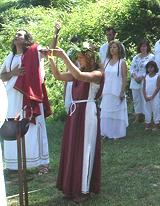 Early in the development of modern Paganism, in the 60s and 70s, it
was felt extremely important that Paganism derive its legitimacy from
deep in the roots of ancient times. Unfortunately, almost nothing was
known of these roots, so it was mostly made up from very sketchy
sources. Today, we deeply respect our ancient roots, but we can stand
on our own. We need not make unsupported claims which are now so easily
debunked by skeptics, archaeologists and historians.
Early in the development of modern Paganism, in the 60s and 70s, it
was felt extremely important that Paganism derive its legitimacy from
deep in the roots of ancient times. Unfortunately, almost nothing was
known of these roots, so it was mostly made up from very sketchy
sources. Today, we deeply respect our ancient roots, but we can stand
on our own. We need not make unsupported claims which are now so easily
debunked by skeptics, archaeologists and historians.
There are two basic approaches to these ancient roots, Reconstructionism and Eclecticism. "We might say that Reconstructionist Pagans romanticize the past, while Eclectic Pagans idealize the future. In the first case, there is a deeply felt need to connect with the past as a source of spiritual strength and wisdom; in the second case, there is the idealistic hope that a spirituality of nature can be gleaned from ancient sources and shared with all humanity." - Religious studies scholar Michael Strmiska.
These two approaches are complimentary and I expect they will gradually move closer to each other. The Reconstructionists work hard to analyze and recreate their past religion accurately, though they may have precious little to work from. Some of what they find is not suited to the modern world. The Eclectics should incorporate more actual historical Paganism, which they can get from the Reconstructionists, and can in turn help the Reconstructionists adjust to the modern world.
Reconstructionism
 The most successful reconstructionist groups are from regions that
have very strong folk traditions. These include the Baltic countries
and Russia. In Abkhazia, which has broken away from Georgia, the Pagan
traditions did not completely die out. Sacred sites were preserved,
and the priesthood persisted to a degree. The Christian churches are
increasingly seen there as tools of the oppressor, with a growing
portion of the population adopting the old religion.
The most successful reconstructionist groups are from regions that
have very strong folk traditions. These include the Baltic countries
and Russia. In Abkhazia, which has broken away from Georgia, the Pagan
traditions did not completely die out. Sacred sites were preserved,
and the priesthood persisted to a degree. The Christian churches are
increasingly seen there as tools of the oppressor, with a growing
portion of the population adopting the old religion.
Some reconstructionist groups try to limit their membership to people of a particular ethnicity, at the risk of being called racist. Due to rapid transportation and migration in the modern world, this is becoming increasingly less viable. What if your father was Lithuanian and you mother was Greek? Clearly, these groups will have to institute flexibility, or they're going to go extinct again.
Some established reconstructionist groups are resentful of ongoing religious studies and archaeology, which have provided new understandings that conflict with their established reconstruction. This has caused some angry exchanges on the Internet. Reconstructionists should be fully prepared to adapt to new knowledge, even if it's not pretty.
Ossetia, in southern Russia and north central Georgia, is a good source for European Pagan material, as it was never successfully converted to either Christianity or Islam, and about a third of the people still adhere to an unbroken native tradition.
Some Pagan groups maintain close relations with Hindu groups. The unbroken Hindu tradition is particularly relative to Pagan revivals in Europe, because it is an Indo-European religion, though one that has a very different history and been very much elaborated.
There are reconstructionist groups working to reconstruct the native religions of the Near and Middle East, but these groups exist almost entirely in North America. Neither Israel nor the Arab regions are hotbeds of religious tolerance.
There is even a reconstructionist group in Mexico, working with the Aztec religion and philosophy. I am presuming they will not be trying to reinstate the mass human sacrifice the Aztecs thought necessary to support the continued existence of the world. That has proven unneeded, as the world is still here, more or less.
Kemetism
 The religion of Ancient Egypt is a special case. Here we have an
intensely Pagan religion with over 3000 years of detailed documentation,
a good amount of which is available in English, German and French. There
isn't a lot to reconstruct here, the main task is to adapt it to the
modern world. This religion has shown adequate adaptability over those
3000 years, so that isn't likely to anger the Gods and Goddesses if
done with care.
The religion of Ancient Egypt is a special case. Here we have an
intensely Pagan religion with over 3000 years of detailed documentation,
a good amount of which is available in English, German and French. There
isn't a lot to reconstruct here, the main task is to adapt it to the
modern world. This religion has shown adequate adaptability over those
3000 years, so that isn't likely to anger the Gods and Goddesses if
done with care.
Kemetism is also the form of Paganism easiest to adapt to a modern, literate, urban society, because that's the kind of society it lived in for most of those 3000 years, a society in many respects much like our own. Further, there are Gods and Goddesses to fill almost any need or preference, and a tradition of appointing new ones as needed. They are also free of attachment - nobody today has a valid claim to ancient Egyptian heritage - not even the lady who claims to have been crowned 196th Pharaoh (in a "secret" ceremony, of course). This is definitely a path a person contemplating Paganism should have a look into. There are a number of Kemetic groups in North America, any number of solo practitioners, and huge amounts of historical data to work with.
The one thing we don't have is descriptions of actual rituals. They were performed every day and passed down from parents to children. The people knew them, so there was no need to write them down. All we have is a few fragmentary descriptions by foreigners, so we are on our own here. Rituals must be created with deep understanding of the nature of what or who is being celebrated.
There is one major factor that makes strict reconstruction problematic.
Paganism is intensely seasonal, and it was in Egypt as well. The
problem is, due to the unique conditions of the Nile Valley, they had
only three seasons, and they are quite at odds with ours. This matter
needs serious work, and I hope someone is on this issue.
Eclecticism
The most prominent examples of eclectic Paganism are Wicca and Druidry, as they are the largest and most long established groups, but there are others, such as the Goddess Movement and Thelema. There is also the category of New Age / Syncretic groups, which blend features of two or more loosely related traditions. Reconstructionists consider syncretic groups "impure" and unacceptable, even if the traditions are legitimately ancient.
It should not be thought that Eclectic Paganism is somehow less legitimate than Reconstructed Paganism. While it is a very different viewpoint, it serves the needs of its practitioners by building its own mythos, and can have a broader appeal than many specific reconstructions. Both have much to offer each other.

Modern Druidism
(Druidry) originated in the 18th century in England, and is made almost completely from new material. Almost nothing was recorded about the ancient Druids, and what little exists is at least partially suspect, written by persons not friendly to the Druids. Modern Druidry was originally a monotheistic movement based loosely on Freemasonry. This changed radically in the 20th century, strongly influenced by various Pagan revivals and archaeologic evidence. Efforts began to reconcile Druidry with what has been learned about Iron Age Celtic culture.While there is no central authority, and various Druidry groups follow somewhat different paths, it is now a largely polytheistic nature based philosophy / religion with strong ecological tendencies. Fortunately, the attested practices of animal and human sacrifice have not been incorporated, but a belief in reincarnation has been. A belief in the indestructibility of the human soul and reincarnation is one of the very few things we can be certain of from the ancient Druids.
Druid groups like to have ceremonies at Stonehenge in England, but Stonehenge was built about 2000 years before the first Druids appeared, by a people almost nothing is known about, except they were very good at astronomical mathematics, and at moving rocks.
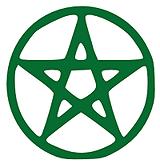
Wicca
, the largest Pagan movement in England and the United States, is compiled from various sources, with a considerable element of reinterpretation and conjecture. It began development in England in the early 20th century as a revival of Celtic Witchcraft, derived from various folk traditions, many of them proving to be far more recent than presumed at the time.The core beliefs of Traditional British Wicca were set down by Gerald Gardener and Doreen Valiente in the late 1940s and early 1950s. Gardener claimed initiation by a secret coven of Celtic witches, but that has never been verified and seems extremely unlikely. Wicca has a much stronger belief in magic than other Pagan practices, most of which do not use the term "witch", except to describe a former wife or girlfriend.
Most Wiccan groups are still very feminist, having been established as a political counter to patriarchal oppression and suppression from the monotheists, in some cases with intense paranoia. At root, the Horned God is of far less importance than the Moon Goddess. Some men get along with the feminism, others consider it excessive, but the majority of Wiccan membership are women, and some circles, like in Dianic Wicca, are exclusive to women and may be predominantly Lesbian.
Wicca has no central authority, and different branches now vary considerably, though most recognize and participate in the seasonal celebrations. Most also adhere to the Moon Goddess and the Horned God, but in some branches they are called the Great Goddess and the Great Horned God, because they are held to have many aspects that can appear as separate gods and goddesses. This is similar to concepts in Hinduism.
Wicca is divided into two general categories. British Traditional Wicca consists of Gardenarian (founded by Gerald Gardener and Doreen Valiente) and Alexandrian (founded by Alex and Maxine Sanders). Other circles have been founded by people not initiated into British Traditional Wicca.
By 2010 there was some backlash against Wicca from other Pagan communities, because in Gardenarian and Alexandrian Wicca the thoughts of the founders had become calcified doctrine. By then, however, a good number of circles had been established far removed from British Traditional, with more flexible and diverse attitudes.

Witches
Today we must make a clear distinction: "Wiccan" is a religion, "Witch" is a calling, and a craft.While Wicca is (extremely loosely) based on ancient Celtic witchcraft, Wiccans generally do not want to be called "Witches", due to the very negative historical connotation. Wiccans generally belong to a Coven or Circle and participate in organized group rituals with others of their Circle.
Most workers in "The Craft", have enthusiastically accepted the term "Witch" and are turning it into a symbol of pride, as other formerly suppressed groups have done with what they were called.
Many serious Witches are refugees from the Evangelical Churches and other repressive forms of Christianity. Most Witches are solo practitioners and do not belong to a coven or other organization. They practice herbalism, healing magic, divination, and other crafts, generally for the public good. Some teach Witchcraft. Not all Witches think of themselves as Pagans, and some think of themselves as Christians.
Many of the most serious Witches are devotees of the Goddess Hekate (say Hekatee, not Hek-kate as Shakespeare did). Hekate is still one of the most misunderstood Goddesses, no thanks at all to Shakespeare, and often pictured as an old, ugly, and wicked queen of darkness. In Classical times, she was always pictured as young, and carrying two torches to help light your way through the darkness. It is she who guided Persephone back from Hades to her mother Demeter. In later antiquity, she was pictured as a Triple Goddess, but all three aspects were young.
Despite all this, by far the largest contingent of "Witches" is "Aesthetic Witches" (there are less polite terms). They love the look, the bling, the rep, and casting spells, but reject the learning, attitude of service, respect for spirits, and deep devotion to The Craft typical of real Witches. Many real Witches do not adopt the look or the bling at all.
Despite all this New Witch attitude and reconceptualizing of witchcraft,
I still love Ambrose Bierce's definition:
"Witch n (1) An ugly and repulsive old woman in a wicked league with the
Devil. (2) A beautiful and attractive young woman, in wickedness a
league beyond the Devil".
Pagan "Conversion"
 A large portion of the Pagan community admits to finding Paganism
largely by accident, often by reading or being exposed to unusual
material. The majority settle in as solo practitioners rather than
joining a Pagan community, not because they reject community, but
that's just what they are comfortable with. They do, however, tend
to keep in communication with other Pagans. The solo practitioners
are a sort of cloud in which the Pagan communities are embedded.
A large portion of the Pagan community admits to finding Paganism
largely by accident, often by reading or being exposed to unusual
material. The majority settle in as solo practitioners rather than
joining a Pagan community, not because they reject community, but
that's just what they are comfortable with. They do, however, tend
to keep in communication with other Pagans. The solo practitioners
are a sort of cloud in which the Pagan communities are embedded.
Pagans generally do not proselytize, but are happy to make information available to anyone interested. Most Pagan groups will gladly welcome persons who are curious about their beliefs and practices (which never include baby eating). Most groups don't advertise, and are found by accident, or through friends.
To join a Pagan community, there are usually some simple qualifications. Usually they include respect for the natural world and environment, acceptance of both the masculine and feminine in Divinity, and a high standard of morality, particularly in the desire to avoid harming others. Acceptance of folks of all nations, races and sexual orientation is almost always included.
For very group ritual oriented groups, being fully accepted is gradual. Personalities being in tune with each other is a serious issue for these groups, and neither side should be in a hurry.
Becoming a Pagan does not require cutting off your familiar community "cold turkey". You are entering a larger realm, which envelopes many viewpoints and practices. You will realize the religion from which you come is a sect of more limited understanding, but probably not completely wrong.
Taking a broad view, there is only one reality, thus all religions are aspects of the one. Unfortunately, some of these aspects consider themselves to be the "One and Only True Way", thus all others are wrong and need to be "corrected", by conversion or death. This has caused an inordinate amount of human suffering.
Pagans maintaining "dual citizenship" with a former religion are fairly common, and this should be respected. Some Pagans take a "mix and match" attitude, drawing from more than one path. This is like many ethnic groups that cheerfully mix their native beliefs and practices with Christianity or Buddhism after conversion.
Accepting Paganism can be easier for Christians than for some religions, because there is so much that will seem familiar. The New Testament embodies concepts that appear influenced by Pagan movements of the time, particularly Roman Mithraism (not closely related to Persian Mithraism) and the cult of Isis and Osiris.
The early Christian churches absorbed a great deal of material from the Pagans. Some local gods and goddesses were adopted as saints, and the system of saints roughly followed the Pagan format. Mary became the new Vesta, Rome's favorite goddess. Pagan festivals were adopted with some adjustments. With Easter, they didn't even bother to change the name or remove the symbols of the fertility goddess, the bunny and the egg. Christmas has now reverted to something rather similar to the Roman Saturnalia. "The Christians took this celebration from us, but in the end, the Pagans won." Of course, the Christians got some of the dates a little off, but, whatever.
One path within contemporary Paganism is Christo-Paganism, where the person's primary deity is Jesus, but practices and attitude are similar to other Pagans. Their Jesus has a name, definition and story, just like other Deities. Some Pagans have a bad reaction to this, understandably, as many are refugees from the Christian Churches, many from the "fire and brimstone" Evangelical Churches.
If the legitimacy of other Deities and other practices are fully accepted, this Jesus could find a legitimate place within the Pagan pantheon. A former Jesuit, who studied the issue intensively, wrote that it might be possible to follow the teachings of Jesus as a Pagan, but not as a Christian, as the teachings of Christianity are incompatible with Jesus' teachings. On the other hand, adapting Jesus to Paganism is not an easy matter, as fully described on our page Jesus & Paganism.
The Pagan Calendar
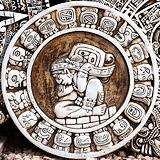 Paganism is closely tied to the Earth, and to the cycles of nature,
thus it is very seasonal. This cyclic nature is carried forward to many
other aspects of nature and human life. Most early Pagan cultures had
major celebrations at solstices and equinoxes, and some of the
cross-quarter days between, but none are known to have celebrated all
of them.
Paganism is closely tied to the Earth, and to the cycles of nature,
thus it is very seasonal. This cyclic nature is carried forward to many
other aspects of nature and human life. Most early Pagan cultures had
major celebrations at solstices and equinoxes, and some of the
cross-quarter days between, but none are known to have celebrated all
of them.
The wheel below (to the left or top) represents the seasonal festivals established by the 20th century Wiccan and Druidry movements in England. The names are from Celtic and Anglo-Saxon, but the modern celebrations may not follow actual practices of those peoples. This wheel has been widely accepted, with names in different languages, by other Pagan groups across Europe, promoting some consistency among different practices.
For Wiccans, the cross-quarter celebrations are the "Greater Sabbats", which follows from the Celtic New Year being Samhain (say "Sowhain", the Celts just got the "w" upside down). The Celts didn't celebrate Mabon and had no Celtic name for it. Somebody just named it after a Celtic hero. This has been controversial, because Mabon didn't have any association with the season, but nobody has come up with a widely accepted alternative. Some just use Fallfest, derived from the Heathen wheel.
Note that the Wiccan day starts at sundown of the previous day, so May 1st starts on the evening of April 30th, but for convenience, most Wiccans use the Gregorian calendar dates. It should be noted that Wiccans also have a lunar schedule of less formal Esbat gatherings, but these are not included by Pagan groups less attuned to the Lunar cycle.
Pagan communities in different regions also have their own special festivals scattered about the year. The second wheel (right or bottom), showing some additional festivals, is from the Heathenism movement in German speaking regions of Europe. For Pagans in the Southern Hemisphere (particularly Australia and New Zealand) the seasonal wheel is rotated 6 months so it coincides with the actual seasons in that region. Conveniently, not many European Pagans live along the equator.

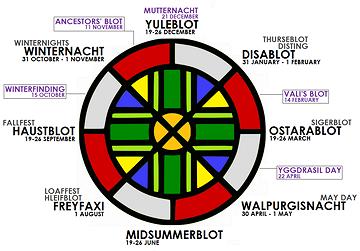
Click on Images for Larger
- Midwinter / Yule: This Winter Solstice celebration has been in practice from at least Neolithic times. It represents the rebirth of the Sun, from a period of declining light to a period of increasing light, and for the Wiccans the rebirth of the god. Christians adopted it as the time of the birth of Christ, though that date is at odds with other aspects of the nativity story. They also adopted many Pagan customs, such as the Yule Log, bringing in evergreen boughs, tree decorating, use of holly and mistletoe, and gift giving. To the Germans and Romans, this was the most important festival of the year.
- Imbolc: This first cross-quarter festival was important as the first stirrings of Spring. To the Celts it was the time when the ewes started to produce milk in preparation for birthing spring lambs. It was also celebrated in Scandinavia as the Dísablót, still represented in Sweden by an annual spring fair. To Celtic Pagans it was dedicated to the fertility goddess Brigid, whom the Christians apparently adopted as Saint Brigid, retaining some of the characteristics of the goddess. The Christians adopted this festival as Candlemas, the time when Jesus was presented at the temple. Imbolc is the time to start spring cleaning.
- Ostara: the Spring Equinox festival, celebrating the successful rebirth of nature. In Anglo-Saxon regions It is dedicated to the fertility goddess Eostre, and in other regions to similar fertility goddess under other names. It was adopted by the Christians as the time of the resurrection of Christ. The name Ostara was retained as Easter, as were the bunny and the egg, symbols of the goddess.
- Beltane: The May Day cross-quarter festival is the second most important festival to the Wiccans. The Romans dedicated it to Flora, goddess of flowers. In Ireland it marked the first day of Summer. Due to its very strong Pagan associations, the Christians did not adopt this as a significant festival, but it continued on with secularized versions of Pagan practices, including Maypole Dancing and crowning of the Queen of the May with plenty of flowers. The ancient Celts held an important bonfire festival on the night leading to May Day. This coincides with Walpurgis Nacht festivals in Germanic countries.
- Midsummer / Litha: The Summer Solstice has been celebrated since Neolithic times and was particularly important thorough northern Europe, from the British Isles on through Russia. It is still a public holiday in some European countries. The Romans dedicated it to Summanus, a thunder god once more important than Jupiter. The Christians adopted it as St. John's Day, celebrating the birth of St. John the Baptist (actual birthday unknown). Some Christian sects consider St. John more important than Jesus.
- Lammas / Lughnasadh: This cross-quarter festival has long marked the beginning of the wheat harvest in Anglo-Saxon England and in Ireland. This is the first of the three traditional harvest festivals, and time to start baking bread for the winter.
- Mabon: The Autumnal Equinox is the second of the Autumn Harvest Festivals. The name "Mabon" was assigned by Wiccans around 1970, named for a character in Welsh mythology. It is less important to Wiccans and to most other Pagan groups than the other festivals. It has no strong ancient Pagan precedent and has not been appropriated by the Christians for anything important.
- Samhain: (Pronounced "Sowane", the Celts just got the "w" upside down) In Celtic times this was the beginning of the New Year, and it is the most important Wiccan celebration, marking the death of the god. It marks the end of the harvest and the time cattle were brought down from summer pasture. It was also the time of slaughter of animals that couldn't be maintained through the winter, and preservation of their meat by drying, salting and smoking. It is also considered a time when the veil separating this world from the Otherworld (realm of the gods, spirits and the dead) is weakest and can be most easily crossed. The Christians, unable to make this most Pagan of celebration go away, repositioned All Saint's Day and All Souls Day here. This all merged together as the modern Halloween.
Astrology
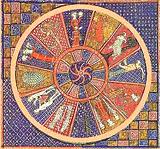 Science has done its best to discredit Astrology, but it remains important
in many cultures. Western Astrology is based on the path of the Sun, the
circle of the Seasons, and how they relate to human development, physical
and spiritual. The actual constellations of fixed stars after which the Signs
are named, have no significance at all, and are, by now, quite out of
alignment with the Astrological Signs.
Science has done its best to discredit Astrology, but it remains important
in many cultures. Western Astrology is based on the path of the Sun, the
circle of the Seasons, and how they relate to human development, physical
and spiritual. The actual constellations of fixed stars after which the Signs
are named, have no significance at all, and are, by now, quite out of
alignment with the Astrological Signs.
It should be noted that understanding Astorology, or belief in Astrology, are not at all a requirement of Paganism. Many Pagans pay no attention to it at all in their practices.
At the very least, Astrology is a complex and powerful symbolic language describing the path of a human through life, and the influences encountered. This language can be useful, and is used, in meditation, psychology, ritual, and magic. This symbolic language is deeply involved with the Calendar and the Elemental Realms.
Another concept is that it is a system of thought entities, created and reinforced in their meanings through the ages by practitioners, until they are powerful enough to actually influence our lives. They are symbolized by the planets, and assigned to them, but are not at all of the physical realm.
If you wish to understand this symbolic language, to any depth you wish, even if just to be conversent, I suggest you read Ivo Dominguez Jr's book Practical Astrology for Witches and Pagans. It is clear, organized, comprehensive, and even logical.
Of course, Astrology is still quite active as a pop-culture toy. It should
also be noted that Hindu Astrology, still very influential in India, uses the
same signs, probably brought from Greece, but they are adjusted to be kept in
alignment with the original constellations. This means the language, methods,
and calculations of Hindu Astrology (sidereal Astrology) are different from
those of Western Astrology (tropical Astrology).
The Elemental Realms
The traditional four elements are totally different concepts from the "elements" of Science - they just go by the same name. They are valid and useful concepts, particularly for personal development, rituals, and magic. They are all considered supportive, transformative and essential to life itself, and central to most Pagan rituals and celebrations.
Fire
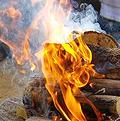 Fires, ranging from candles to bonfires, are almost universal in
Pagan practices. The smoke from fires is expected to carry prayers
to the gods. Fire alters are common in a number of traditions, and
are important in the seasonal celebrations.
Fires, ranging from candles to bonfires, are almost universal in
Pagan practices. The smoke from fires is expected to carry prayers
to the gods. Fire alters are common in a number of traditions, and
are important in the seasonal celebrations.
This is a natural thing, given the central place of fire in the development of humanity. Paleoanthropologists have found evidence that fire was already in use by our last pre-human ancestors. They believe the use of fire to cook foods was what enabled development of the large brains we enjoy today. Brains are very energy costly and difficult to maintain on a raw foods diet.
Fire was also critical for protection from predators, for keeping warm during ice ages, and for crafts. Very early humans were already using fire to condition flint to make better, sharper blades. Later it was used to fire pottery and melt metals. Most Pagan rituals and ceremonies use Fire as a tool.
Using fire as protection from predators proved very important in human development. It allowed safe sleep on the ground, which made profound changes in the human sleep cycle. One result was the ability to organize much larger communities.
In Magic, fire is usually represented by, well, fire, but in the Tarot, or in the hands of a Sourcerer, and most Ceremonial Leaders, it is a Wand, perhaps originally representing a torch, or the fire of growing things. In Gardenarian Wicca, fire is represented by the Sword or Athame (ceremonial knife), used for Air in other practices. I consider this a serious error, but Gardener was really into knives.
Water
 All life on Earth originated in the sea, and in most Pagan traditions
the world started with a rising of land from a primordial sea, by one
means or another. We are all still creatures of the sea, but carry the
salt sea within us - our blood and other fluids.
All life on Earth originated in the sea, and in most Pagan traditions
the world started with a rising of land from a primordial sea, by one
means or another. We are all still creatures of the sea, but carry the
salt sea within us - our blood and other fluids.
In Magic and the Tarot, the symbol for Water is the cup, chalice or caldron. Water is considered very transfomative and important in cleansing and initiations (for instance, Christian baptism). Bodies of water have always been associated with important spirits, gods and goddesses, and magical workings. In many workings it represents the realm of love.
Aside from its use in almost all cleansing and transformation rituals, Water is also a carrier for the ingredients in potions of all sorts, magical and other.
Air
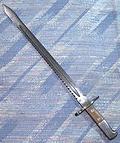 Air is the very breath of life, without which our lives and the lives
of all the creatures of the Earth would be impossible. Even the creatures
of the sea depend on air dissolved in the water.
Air is the very breath of life, without which our lives and the lives
of all the creatures of the Earth would be impossible. Even the creatures
of the sea depend on air dissolved in the water.
In the cycle of Air, plants take in carbon dioxide, break it down, and breath out oxygen. Animals take in oxygen, combine it with fuels and breath out carbon dioxide. The process is far more complex, but that will suffice to show the interdependency of plants and animals.
In Magic, and the Tarot, the symbol for Air is the sword. Another working tool in the realm of air is feathers, or even whole wings - gifts from the creatures of air. The exception is Gardenarian Wicca, where the Sword (or Athame) represents Fire, so they use incense as the symbol for Air.
Air represents intellect, observation, analysis and the scientific method, thus the sword image, the cutting edge. It also represents communication, between people and to the other entities, through sound - and hopefully not by the sword.
Earth
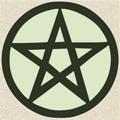 Earth is the mother of all living things. We are born from the
Earth and to the earth we will return, despite attempts at preserving
the dead - the Earth abides, and will claim them at last.
Earth is the mother of all living things. We are born from the
Earth and to the earth we will return, despite attempts at preserving
the dead - the Earth abides, and will claim them at last.
Earth nourishes all living things. Even creatures of the sea depend on nourishment washed down from the land. The progression of seasons is of vital importance - though many in North America are removed from it, it is nonetheless critical to their survival.
In earlier times, people were much closer to the seasons and their effect on life - thus the extreme importance of the seasonal celebrations and rituals in all Pagan practices. A poor harvest was a disaster - even conquering armies could not march if the harvest had not been good. Most Pagan rituals and celebrations involving Earth are in the nature of giving thanks.
In Magic, Earth is represented by salt, crystals or stones. In tarot, Pentacles is the suite of Earth, or in some decks, coins.
Mind Altering Substances
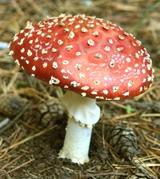 Natural mind altering substances have been used in religious
practices since the beginning of humanity, usually to provide a gateway
into other realms. Use of the stronger substances was generally by
shamanic specialists, but sometimes within larger groups.
Natural mind altering substances have been used in religious
practices since the beginning of humanity, usually to provide a gateway
into other realms. Use of the stronger substances was generally by
shamanic specialists, but sometimes within larger groups.
Due to location and dating of recent finds, archaeologists have come to suspect the first settled agricultural communities were established at ceremonial sites, to provide a reliable supply of beer and wine for the seasonal rituals and celebrations. A 6100 year old wine making operation recently found in Armenia is of such sophistication as to clearly show it was not a new invention. It is associated with a burial ground.
Today, natural psychedelics are used mainly by non-European native practices, and still usually by specialists or under their supervision. Beer, and particularly wine, are quite common enhancements to ritual and celebration for nearly all Pagan practices of European descent, and wine is even important to some Christian practices.
Food
 Pagans are very serious about food. It is a major connection between ouselves
and the Earth. Food should be in as close to a natural state as is practical,
but most should be cooked. Our pre-human ancestors learned to control fire and
cook food, bringing the high nutrition that made us possible.
Pagans are very serious about food. It is a major connection between ouselves
and the Earth. Food should be in as close to a natural state as is practical,
but most should be cooked. Our pre-human ancestors learned to control fire and
cook food, bringing the high nutrition that made us possible.
Unnatural foods should be rejected as damaging to our bodies and to the Earth. Preparing food should be done with conscious care, as a sacrament honoring the Earth, and honoring our very distant ancestors who's fires enabled us. It should be considered an art, not a labor.
Many Pagans are vegetarians, as part of their desire to be shepherds of the Earth, honoring all living creatures. On the other hand, we are of the animal kind, and have no choice but to live by taking life from other beings. Plants too have awareness.
We must constantly express our thanks for the nourishment we receive, and give thanks directly to the beings we take that nourishment from, not to a remote mythical third party in the sky. Here I have posted a simple ritual of thanks, to be recited silently or voiced: Thanking for Sustenance. If some cynical Christian, knowing you are Pagan, asks you to say grace at Thanksgiving, they will be surprised - use the Group Leaders version so they are included.
Food is also a very important factor in Community, a major aspect in some modes of Paganism. This also includes Hospitality, Charity, and offerings to Gods, Goddesses, Ancestors and assorted spririts. Animal sacrifices and burnt offerings, however, are not features of contermporary Paganism.
Of course, this site, Clovegarden.com is primarily about food, but for a lot more on the relationship between food and Paganism, see Gwion Raven's book The Magick of Food.
Sexuality
 Sexual reproduction is critically important to the evolution of
living beings, including animals, plants, fungus, algae, and others.
Evolution was extremely slow until sexual reproduction developed -
then it took off like gang busters. In advanced beings, asexual
reproduction is a one-way street to oblivion. Even with sexual
reproduction, an insufficiently diverse gene pool is a severe
disadvantage.
Sexual reproduction is critically important to the evolution of
living beings, including animals, plants, fungus, algae, and others.
Evolution was extremely slow until sexual reproduction developed -
then it took off like gang busters. In advanced beings, asexual
reproduction is a one-way street to oblivion. Even with sexual
reproduction, an insufficiently diverse gene pool is a severe
disadvantage.
The mechanisms of sexual reproduction are very complex, even among plants and animals, but within humanity they are an order of magnitude more complex. Sexuality has been put to service far beyond simple reproduction, and is a major factor in family and community cohesiveness and organization. Naturally, sexuality is prominent in Pagan practices, appearing in various forms, especially in the progression of the seasons.
Human sexuality is very powerful, and rather erratic. Given its complexity, there are lots of ways for it to go awry, and we see that even among animals. There are many variations, and these variations are built into a person's gene structure. They are not by choice, and they are not something that can be changed by "reeducation". Pagan communities have been in the forefront of accepting the LGBT for what they are, people as worthy as any other. Some circles In Dianic Wicca are entirely Lesbian, and the all male Radical Faeries are considered to fall within the realm of modern Paganism.
Pagan communities tend also to be liberal in regard to normal heterosexual activity. On the other hand, Pagans are serious about the world's natural environment, and the most pervasive destroyer of that environment is overpopulation, so birth control is a serious issue - also, there's always that little matter of personal responsibility to contend with, and in developed countries, the horrifying expense.
Sexual variations that harm others are in violation of important Pagan principles and are intolerable. Sexual behavior between (or among) people must be consensual, with all parties aware of how it will go, and all with the ability to say "stop". Because human development is very slow, we have the concept of "age of consent". Persons below that age do not fully comprehend the consequences, so cannot give consent, and older guardians are not authorized to speak for them in these matters. It's strictly "hands off".
Pagan Groups, Organizations & Publications
Despite continuous attacks from Christian organizations and popular media equating Paganism with Satanism, Pagan communities are growing in size and numbers. In no way can they be characterized as "Satanic". Satanic cults are "reversal" offshoots of Christianity and Judaism, not at all related to the indigenous pre-Christian religions or to modern Paganism.
Few Pagan groups ever proselytize for new members, but are welcoming to people who find a home in them. They are usually low key and a little difficult for interested people to find. People who have studied Pagan communities have noted the membership is generally well educated and avid readers, and often find artistic inspiration from Paganism.
It is rather difficult to get good statistics on the number of people who consider themselves Pagan, especially since organizations are so decentralized, and well over half of Pagans are solo practitioners. There is also fear of extreme prejudice from Christians, and even death threats (sometimes carried out) from Muslims. Some numbers have been compiled for English speaking regions:
- England: 42,262 by 2006 census, up to 250,000 by other estimates.
- Ireland: 2000 to 3000, estimated.
- Canada: 21,080 by 2001 census.
- United States: over 1,000,000 by estimate from Pew Research, based on extensive polling.
- Australia: 32,083 by 2011 census.
- New Zealand: 6,804 by 2006 census.
Wikipedia maintains a List of Neopagan Movements with links briefly describing well known organizations. Of course, for such a decentralized movement there are a great many small groups which may or may not be associated with the listed groups.
Nearly all Pagan communities are peaceful, entirely harmless and welcoming, but there are a few exceptions. In German speaking Europe there is some revival of the German Occultism that contributed to Nazi mythology and anti-semitism, and there are some Neo-Nazi groups that hide themselves by pretending to be Heathen religious groups. There is also Wotanism (Wotansvolk) in North America, which is very popular among White Supremacists in prison populations. These are dangerous groups to be avoided.
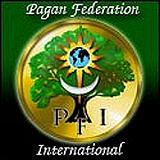
Pagan Federation International
The Pagan Federation (PF) was started in the UK in 1971 to
distribute information and protect the rights of Pagans. It was primarily
of Wiccan origin. Some members were in other countries, so the Pagan
Federation International was eventually formed to better serve them.
This organization was greatly enabled by the rise of the Internet, and
broadened to cover many forms of Paganism. In 2006 PFI became the
foundation "Stichting Pagan Federation International", registered in
The Hague, Netherlands, #27282660. Legal Separation from PF was complete
and the two are now "affiliate organizations". PFI has branches in at
least 35 countries and all permanently inhabited continents. The PF has
been freed to retain its very UK and Wicca orientation. It publishes a
substantial quarterly magazine, Pagan Dawn, now in its 45th year,
which the PFI makes available to members at additional cost.
The mission of PFI is simple:
- To promote and defend the rights of Pagans.
- To support the rights of Pagans to worship freely and without censure, regardless of their race, gender, nationality or cultural background.
The principles of the organization are:
- Love for and Kinship with Nature. Reverence for the life force and its ever-renewing cycles of life and death.
- A positive morality, in which the individual is responsible for the discovery and development of their true nature in harmony with the outer world and community. This is often expressed as "Do what you will, as long as it harms none".
- Recognition of the Divine, which transcends gender, acknowledging both the female and male aspect of Deity.

The
Pagan Pride Project
Sponsors festivals and fairs in various locations around the United States, Canada, Latin America, and Europe. This is an inclusive organization and all manner of pagans are welcome. The sponsored events vary widely by location, but usually feature lectures, demonstration ceremonies, and a wide array of vendor booths. Sometimes additional entertainment is provided by Christian protestors. These events are put on by more or less independent regional organizations, so some events are quite regular, and others are quite erratic. They vary from modest picnics to larger events like the 2019 Los Angeles and Orange County event, featuring about 57 vendor booths and many workshops and rituals. It was well attended and there were no protestors. The Pagan Pride Web site provides dates and locations for upcoming events.Goal:
The organization aims, through education, activism, charity and
community, to promote tolerance and understanding among people with
different belief systems. For Pagans, the project aims to help them
find pride and confidence in their chosen path. For non-Pagans, the
project aims to help in understanding Pagan friends, coworkers and
family members.

European Congress of Ethnic Religions
Where the PFI is quite liberal, as you would expect from it's Wiccan roots, the ECER is hard core reconstructionist. This organization was formed in 1998 in Vilnius, Lithuania as the "World Congress of Ethnic Religions". Founding organizations were from Lithuania, Poland, Denmark and Belgium. The name was changed in 2010 to "European Congress of Ethnic Religions" to reflect reality, though it does maintain ties to Hinduism and has held two annual meetings in India.
Goal:
- The purpose of the ECER is to serve as an international body that will assist Ethnic Religious groups in various countries and will oppose discrimination against such groups.
- By Ethnic Religion, we mean religion, spirituality, and cosmology that is firmly grounded in a particular people's traditions. In our view, this does not include modern occult or ariosophic theories/ideologies, nor syncretic neo-religions.
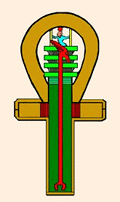
Church of the Eternal Source
Devoted to reconstruction of the Ancient Egyptian religion, CES is the oldest non-profit Kemetic organization. Established in California in 1970 and granted non-profit status in 1971, it describes itself as a "A Federation of Neo-Egyptian Reconstruction Temples". This reflects its non-centralized structure.
After the last of the founders died in 2010, the Church went dormant through a period of evaluation and reconsideration. As of August 2017 it has returned to the public realm. Under the guidance of Dr. Michael Poe, it plans to post about 1800 documents regarding Egyptian religion on its Web sites, and to begin an on-line religious training program. Disclaimer: Andrew Grygus, writer of this document and publisher of Clovegarden.com, has become a member of this organization in honor of the founders, who were friends of his many years ago. He is not an officer of the the Church, nor currently authorized to found a Temple.

Circle Sanctuary
This extremely important organization was founded in 1974 by Celina Fox. While sometimes classed as Wiccan, it has a much broader appeal and describes itself as a Nature Spirituality church. It has been at the very forefront of the struggle to preserve the rights of Pagans and end discrimination, through political and legal means, including a long battle to get the Veterans Administration to approve the Pentacle symbol for veteran grave markers. The group is based in a 200 acre nature preserve in southwest Wisconsin, USA. It holds festivals and produces a magazine and other publications. Definitely worth supporting.

Witches & Pagans
- "Earthwise Spirituality for Today"I strongly recommend this quarterly magazine for people who would like to delve more deeply into these subjects. It serves two communities that don't always see exactly eye to eye, but remain largely compatible. This is the result of merging two magazines for better resource allocation.
Each issue focuses on a single subject, but has plenty of other material as well. The columnists and contributors are excellent, and even the letters column is amazing. Much serious philosophy here.
BBI Media also publishes two other magazines, Sage Woman "Celebrating the Goddess in every Woman" and Crone "Women coming of Age".
BBI Media
PO Box 687
Forest Grove, OR 97116
USA
Disclaimer
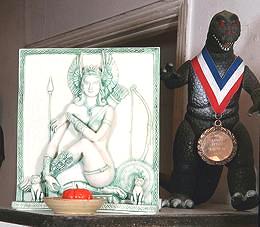 I am a largely Non-Theist Pagan, but have recently been doing some work
with Freya, who seems to be branching out from her Germanic roots -
note her very India style pose and Japanese companion (Shinto I presume).
It's all OK, since Vedic Hinduism originated from the same Proto
Indo-European root as Germanic Paganism.
I am a largely Non-Theist Pagan, but have recently been doing some work
with Freya, who seems to be branching out from her Germanic roots -
note her very India style pose and Japanese companion (Shinto I presume).
It's all OK, since Vedic Hinduism originated from the same Proto
Indo-European root as Germanic Paganism.
Andrew Grygus
